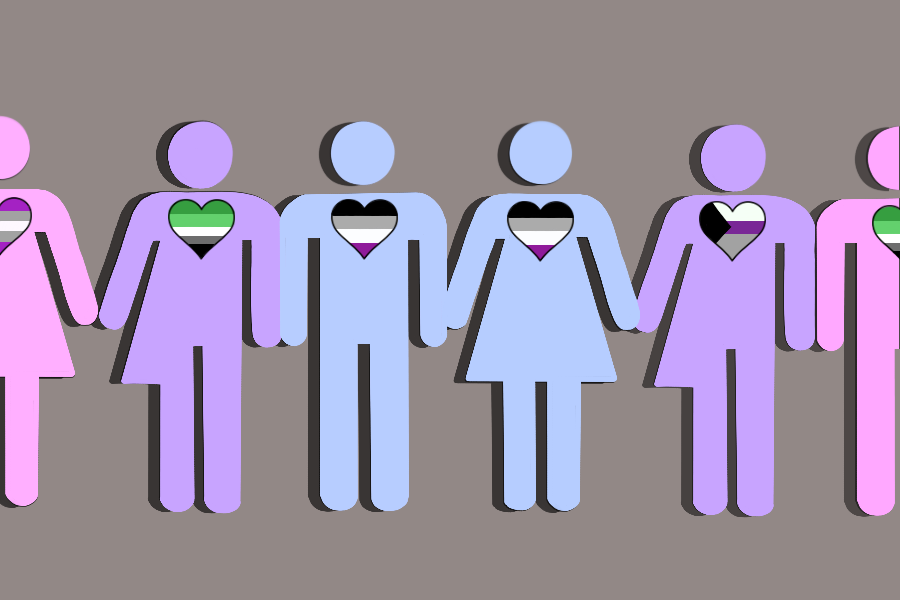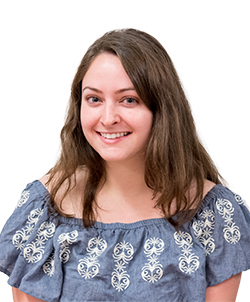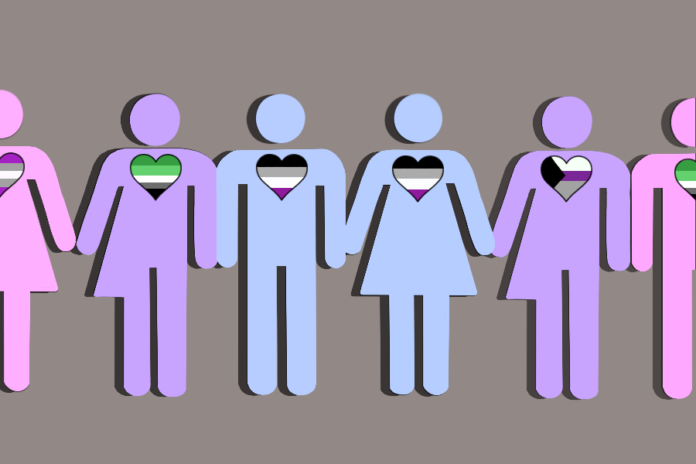
Davis asexuals discuss experiences of being overlooked members of the LGBTQIA community

When Claire Rapp was in high school, she began to notice a difference between her and the rest of her classmates. Rapp, who had numerous relationships with religious men practicing abstinence, was confused as to why she able to brush off sex so easily. After all, she wasn’t religious herself and saw no moral imperative to wait until marriage. Her confusion culminated during her senior year, when she was in a relationship with a man for whom she especially cared. Rapp didn’t understand why she had no sexual interest in someone with whom everything — at least on paper — aligned. She searched for answers online. One just clicked: she is asexual.
“I thought I was super normal and everyone was just bonkers,” said Rapp, a fourth-year environmental policy analysis and planning major. “And then over time you sort of realize that your experiences aren’t normal.”
Asexuality is defined as a lack of sexual attraction, although “aces” — an umbrella term for anyone who identifies as being somewhere on the asexuality spectrum — experience varying levels of interest in sexual activity. Demisexuals may experience sexual attraction only in the context of a powerful emotional connection, while gray-asexuals fall somewhere between asexuals and allosexuals (people who aren’t asexual).
Asexuality, like other sexual orientations, is not a choice, and therefore differs from celibacy — the intentional abstaining from sexual activity. Although some asexual individuals do decide to remain celibate, many also choose to engage in sex for various reasons, such as compromising in a relationship, wanting to have children or experimenting to better understand their sexuality.
For most allosexual individuals, sexual and romantic attraction have always been bundled together, making it hard to imagine them as two distinct, separable phenomena. But ace individuals often still feel romantic attraction toward others, as well as a drive to cultivate intimate, loving relationships — just without an intrinsic interest in pursuing the sexual aspect.
“When I try to explain it to my coworkers when they ask, I’ll usually say, ‘You know how if you ever go somewhere and you’re trying to hook up with someone, you’ll look at them and think, ‘I’d be down to have sex with them’? My thing stops with, ‘I want to cuddle with them,’” said Nicole Neeley, a fourth-year microbiology major. “I’ve never looked at anyone and been like, ‘I’d tap that,’” she added with a laugh.
Diverse romantic identities span the asexual community, but all ace people share the desire to feel connected with others — a feat that can sometimes be challenging in an overwhelmingly sexual world. When Rapp, a heteroromantic asexual person, first arrived at Davis, she struggled through a phase common in the asexual experience: a poignant loneliness grounded in the feeling of being different than seemingly everyone around her.
“The narrative in college, especially during the orientation process, is a whole lot of safe sex ed, a whole lot of sex positivity — which is fantastic and important and healthy and wonderful, and I’m so glad they do it,” Rapp said. “But it’s incredibly isolating when you’re asexual.”
In search of others like herself, Rapp looked to the LGBTQIA Resource Center but was disappointed to learn that, save a binder of information, UC Davis didn’t offer any resources for aces. A few months later, however, the center asked her to participate in an ace awareness event they were planning. Rapp and another asexual student soon began hosting weekly educational, discussion-based meetings about asexuality, which Rapp registered as the official Ace Club at the start of her second year. The organization has since expanded from a mere two members to a vibrant, diverse community of aces who span the spectrum, peaking at 36 members at the beginning of last fall.
“The ace community was one of the driving forces in me coming to Davis,” said Caitlyn Sampley, a first-year cinema and digital media and theatre and dance double major and panromantic ace. “I had no idea where Davis was, or what it was, or what I was going to do when I got there, but I was walking around in the Quad and the Ace Club had their A-frame out. And everything in me just stopped, and I was like, ‘This is real! There are ace people besides me!’”
***
The asexual movement emerged in 2001 when David Jay, an asexual activist and at the time an 18-year-old college student, launched the Asexual Visibility and Education Network (AVEN), a website devoted to providing education about asexuality and a supportive online community for aces. Over the years, AVEN has become the primary place for ace individuals across the globe to assemble and discuss their identities. The organization now champions tens of thousands of members worldwide.
“I really wanted to create a space for us to come together and […] talk about what it meant to be asexual in a culture that a lot of times assumes that if you’re not forming a sexual relationship you’re not really achieving emotional intimacy,” Jay said in a phone interview. “A lot of us really wanted to challenge that idea, and I think we have in a lot of ways over the years of our community.”
Thanks to support from the broader LGBTQIA community, Jay and other ace activists have translated the energy from AVEN into wide-reaching, tangible change — from getting asexuality delisted in the DSM-5 as a mental disorder to successfully advocating for ace-inclusive sex education in schools. The ace movement was built on decades of empowering activism by other sexuality and gender identity-based communities. And many ace youths, such as Rapp, have flocked to and found refuge in their local LGBTQIA centers — which have welcomed them with open arms and hearts.
Still, some members of the LGBT community have questioned whether asexuality holds a legitimate place in the overall queer community. Compared to other identities within the LGBTQIA community, asexuality doesn’t carry the same history of systemic discrimination and violence, and it’s important for ace individuals to recognize that their sexuality alone doesn’t necessarily topple their other platforms of privilege. The level of quantifiable discrimination shouldn’t be a qualifying factor in their ability to identify as queer or apart of the LGBTQIA community. The experiences of two different LGBTQIA identities shouldn’t be pitted against one another. Individuals of all LGBTQIA identities have confronted alienation that has pushed them to seek a community in which they can relate to one another and feel supported. The ace community is no different in this respect.
It’s also crucial for allosexuals to understand that aces — whether they possess intersecting identities or not — face their own prejudices, challenges and feelings of isolation and demonization from outer society. Because sex and intimacy are often considered intertwined, many people wrongly perceive aces as being fundamentally broken and in need of a “cure.” And according to one academic study, asexual individuals are frequently characterized by heterosexuals as machine-like, emotionless and inhuman. The study also found that, out of all sexual identities, the surveyed population wanted the least amount of contact with asexuals, and were even less willing to hire or rent an apartment to an asexual person.
“There’s so much placed heterosexuality in every movie, in every book, in every sense of what you see in the world, that it seems just unnatural and wrong and awful to not feel some kind of sexual attraction — which is I guess why people are afraid of it [asexuality] or admonish it,” Sampley said.
With an estimated 1 percent of the population being asexual, and with a considerable amount of them choosing to remain silent about their sexuality, many people go their entire lives without coming across an “out” ace individual.
Accurate media portrayals of ace individuals play an integral role in creating visibility and dispelling misconceptions about asexuality. As of now, there have been few complex, nuanced depictions of aces in the mainstream media — most likely because asexuality is generally misunderstood and television writers don’t know how to construct intriguing storylines for ace characters.
Fortunately, groups like Aces of L.A. are visiting writers’ rooms to pitch compelling ace plotlines beyond the archetypal narrative of inescapable loneliness and the inability to form romantic relationships. Well-written ace characters are vital to helping asexual viewers feel more represented and less alone while also educating audiences that wouldn’t have been reached otherwise.
Ace-inclusive education — for which Jay recently advocated in New York — is another effective way to spread awareness and foster acceptance. This kind of education is important not only in helping ace youths discover their identities, but also in unspooling the complex relationship between romantic and sexual attraction, between love and the desire for sex as well as the need for communication and consent in relationships.
Although the ace movement began as a way to support other aces, activists like Jay are now hoping to help everyone examine the ingrained playbook of romantic relationships. He wants a broader discussion of sexual expectations and stereotypes entrenched in different cultures, belief systems and even neighborhoods. All people, regardless of sexual orientation, could benefit from challenging the script of how good, healthy and traditional relationships function — as well as questioning what it means to be intimate, to develop meaningful connections and to simply be human.
“There is a real desire among everyone to break out of the script of intimacy that exists in our culture,” Jay said. “As aces, we’re leading the way. We’re not walking away from everyone else — we’re creating a path that everyone else wants to follow.”
The Davis Ace Club meets every Friday at 4 p.m. in the LGBTQIA Resource Center and is open to aces and allies alike.
Written by: Taryn DeOilers — tldeoilers@ucdavis.edu
Disclaimer: The views and opinions expressed by individual columnists belong to the columnists alone and do not necessarily indicate the views and opinions held by The California Aggie.





